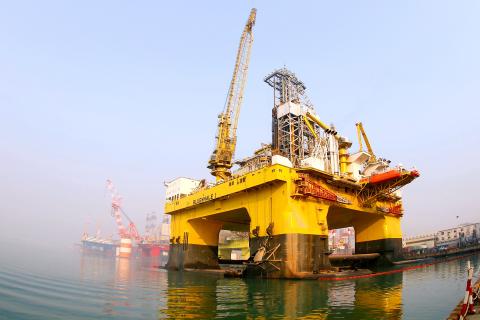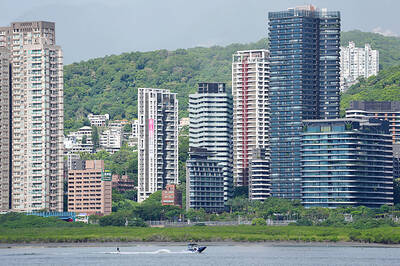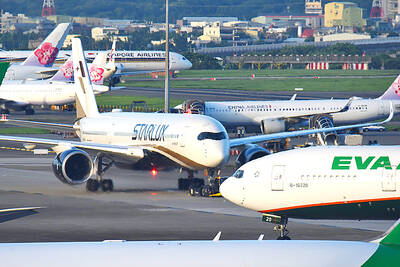China is drilling deep into the ocean floor in the hope of tapping vast deposits of a frozen fossil fuel known as “combustible ice,” but it would be years before it is part of the global energy mix.
Gas hydrates are found in the seabed as well as beneath permafrost, but experts say extracting methane from the ice crystals is technologically challenging and expensive.
Energy-guzzling China, one of several nations hoping to exploit the hard-to-reach resource to meet growing demand, announced a “historic breakthrough” in drilling tests in the South China Sea.

Photo: AFP
In six weeks, China extracted more than 235,000m3 of gas hydrate off the coast of Guangdong Province, a statement on the China Geological Survey’s Web site said.
“China has beaten expectations in completing the trial explorations of combustible ice using local innovations in technology and engineering,” Guangzhou Marine Geology Survey head Ye Jianliang (葉建良) said. “It marks a historic breakthrough.”
One cubic meter of gas hydrate, which is also known as “flammable ice” because methane can ignite, releases 164m3 of conventional natural gas once extracted, the US Department of Energy says.
Methane is extracted by heating or reducing the pressure inside the well to break down the hydrates.
Estimates for the size of the planet’s gas hydrate deposits vary widely, but the US department says it could exceed “the combined energy content of all other known fossil fuels.”
Analysts say the substantial resource could be a “game changer” for nations that have limited access to conventional natural gas.
“The perfect example is Japan because they don’t have much conventional gas and for them it could be an important reserve,” University of Auckland senior lecturer of geophysics Ingo Pecher said.
Japan is heavily reliant on liquefied natural gas imports, with most of the nation’s fleet of nuclear reactors still offline more than six years after the 2011 tsunami disaster at Fukushima.
“It boils down to economics,” Pecher said.
While known and presumed gas hydrate deposits have been identified from New Zealand to Alaska, the challenge is to find ones that are highly concentrated and accessible.
Several nations are hoping to turn gas hydrate into a viable source of energy, including Japan, which has reported drilling success off its Pacific coast.
The US, which is also looking into the potential of gas hydrate, has obtained positive results from exploratory drilling in the Gulf of Mexico.
However, commercially viable production is “another 10 years” away, said Paul Duerloo, partner and managing director at Boston Consulting Group in Tokyo.
“We know where the resource is, the technology we need to apply, but the production rates out of the wells are not commercially sustainable at the current prices,” Duerloo said, adding that shale gas — another unconventional energy source that faced similar challenges — took a long time to “take off.”
China expects to start commercial production of gas hydrate “around 2030,” the Chinese Ministry of Land and Resources said.
Another concern surrounding gas hydrate extraction is the potential for methane — a greenhouse gas — to leak into the atmosphere and fuel global warming, said Xu Yuan (徐袁), an associate professor at the Chinese University of Hong Kong’s geography and resource management department.
Nevertheless, gas hydrates have “huge potential” if the cost and technological hurdles can be overcome, he added.

Taiwan’s rapidly aging population is fueling a sharp increase in homes occupied solely by elderly people, a trend that is reshaping the nation’s housing market and social fabric, real-estate brokers said yesterday. About 850,000 residences were occupied by elderly people in the first quarter, including 655,000 that housed only one resident, the Ministry of the Interior said. The figures have nearly doubled from a decade earlier, Great Home Realty Co (大家房屋) said, as people aged 65 and older now make up 20.8 percent of the population. “The so-called silver tsunami represents more than just a demographic shift — it could fundamentally redefine the

The US government on Wednesday sanctioned more than two dozen companies in China, Turkey and the United Arab Emirates, including offshoots of a US chip firm, accusing the businesses of providing illicit support to Iran’s military or proxies. The US Department of Commerce included two subsidiaries of US-based chip distributor Arrow Electronics Inc (艾睿電子) on its so-called entity list published on the federal register for facilitating purchases by Iran’s proxies of US tech. Arrow spokesman John Hourigan said that the subsidiaries have been operating in full compliance with US export control regulations and his company is discussing with the US Bureau of

Businesses across the global semiconductor supply chain are bracing themselves for disruptions from an escalating trade war, after China imposed curbs on rare earth mineral exports and the US responded with additional tariffs and restrictions on software sales to the Asian nation. China’s restrictions, the most targeted move yet to limit supplies of rare earth materials, represent the first major attempt by Beijing to exercise long-arm jurisdiction over foreign companies to target the semiconductor industry, threatening to stall the chips powering the artificial intelligence (AI) boom. They prompted US President Donald Trump on Friday to announce that he would impose an additional

China Airlines Ltd (CAL, 中華航空) said it expects peak season effects in the fourth quarter to continue to boost demand for passenger flights and cargo services, after reporting its second-highest-ever September sales on Monday. The carrier said it posted NT$15.88 billion (US$517 million) in consolidated sales last month, trailing only September last year’s NT$16.01 billion. Last month, CAL generated NT$8.77 billion from its passenger flights and NT$5.37 billion from cargo services, it said. In the first nine months of this year, the carrier posted NT$154.93 billion in cumulative sales, up 2.62 percent from a year earlier, marking the second-highest level for the January-September